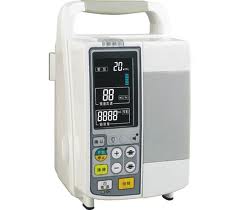Infusion Pump

An infusion pump is a device used to deliver fluids, medication, or
nutrients into a patient's circulatory system, primarily through intravenous
means, although subcutaneous, arterial, and epidural infusions are also
occasionally employed.
These pumps offer precise delivery mechanisms that would be impractical or
unreliable if carried out manually by healthcare staff. For instance, they
can administer minute injections as small as 0.1 mL per hour (too minute for
traditional drips), injections at regular intervals or on-demand, and fluids
with variable volumes dictated by specific times of the day.
Infusion pumps are typically operated through a user interface that requires
input from technicians or nurses during setup:
- Continuous infusion involves small pulses of fluid delivered at a rate
determined by the programmed speed.
- Intermittent infusion alternates between high and low infusion rates to
prevent cannula blockages, commonly used for administering antibiotics.
- Patient-controlled infusion allows patients to control the rate of
infusion within preset limits, often used in patient-controlled analgesia.
- Total parenteral nutrition requires an infusion pattern similar to regular
mealtimes.
Certain pumps offer functionalities allowing adjustment of infusion rates
based on circadian rhythms, crucial for certain medication regimens.
There are two primary types of infusion pumps: large volume pumps, capable
of delivering substantial amounts of nutrient solutions, and small volume
pumps, which administer hormones or medicines like opiates.
Large volume pumps typically utilize peristaltic pump mechanisms, employing
computer-controlled rollers or finger-like components to compress a
silicone-rubber tube through which the fluid flows. Small volume pumps, on
the other hand, use computer-controlled motors to drive a screw that pushes
the plunger of a syringe.
In makeshift medical scenarios, a common improvisation for an infusion pump
involves using a blood pressure cuff around a fluid bag or placing the bag
beneath the patient to regulate infusion pressure. However, this method is
not without risks, as flow rates can fluctuate significantly based on the
patient's blood pressure or weight.
In resource-limited settings, pressurized infusion systems are often used,
employing purpose-designed plastic pressure bottles pressurized with
disposable syringes. While less sophisticated than electronically controlled
pumps, these systems require more nursing attention but offer improved flow
control.
Infusion pumps may also utilize osmotic power, where a salt solution absorbs
water, expanding its volume and pressing medicine out at a controlled rate.
Additionally, spring-powered clockwork infusion pumps are utilized in
veterinary and ambulatory settings.
For battlefield applications requiring rapid and large-volume fluid
perfusion, specialized infusion pumps have been developed. These pumps are
meticulously designed to mitigate various failure modes that could pose
risks to patients, such as overdose, underdose, reverse flow, and air
embolism.
undo Medical Equipment